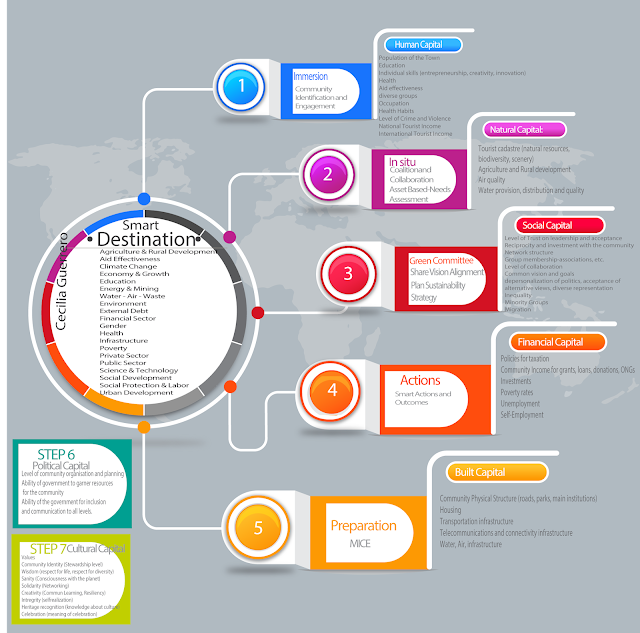CRISP: Building on national/regional initiatives, how will community resource and socioeconomic studies give you that ‘individual data’?
CRISP:
Building on national/regional initiatives, how will community resource and
socioeconomic studies give you that ‘individual data’?
By
Cecilia Guerrero
Tourist communities
show socioeconomic inequities and significant gaps in various areas, including
access to opportunities as well as benefits from economic development.
Evaluating a community to understand its socioeconomic status requires focusing
not only on income distribution, but
also on quality of life attributes as well as the opportunities and privileges
afforded to people within the community. Data collection provides access to an understanding
of poverties both at the human level as well as assets and challenges at the
community level. Socioeconomic data allow us to analyze how this information
affects human behavior, including the physical and mental health and its consequences
for lower educational achievement, poverty and poor health, ultimately affecting
our society at large. Inequalities in health distribution, resource
distribution, and quality of life indicators are increasing in tourist
communities. Data collection helps identify priorities and what needs to be
improved. Our Smart Destination Initiative begins with collecting baseline
information that informs interventions to address poverty at multiple levels:
economic, sociocultural, environmental, infrastructure, and most significantly,
human capital.
The main goal of Smart Destinations
(SD) is “to transform a tourist community into a smart destination through the
implementation of sustainable development practices based on the use of ICT
& Connectivity (internet-intranets), where education is the entry point for
the improvement of quality of life, ensuring a constant improvement in
sustainable economic, social, environmental development and behavior change (with
both guests and locals as stewards of the destinations). SD is a holistic approach based on the
evaluation of human development (poverties) level of the seven capitals as well
as community assets, using an intervention toolbox that targets tourism destination
communities.
The proposed toolbox is based
on the work of various authors with experience in community development and
organizational change: the work of the Taylors, Ontario Healthy Communities
Coalition and Asset Based Community Development, Kotter, University of Kansas, the
Beyond Chacay Foundation´s theory of transformation, and Mark Reiner´s DP640 Case
Study. This toolbox provides ideas, information, community
resource and socioeconomic data collection, human development evaluation and new processes that could
be included in new or existing community development programs. In addition,
local governments are challenged to have a more holistic view on how to approach
a community focusing on stakeholders and leadership development. See annex.
This
Smart Destinations CRI is strategically aligned with the toolbox (SP). Each
step proposed needs to follow a sequence based on data collection for analysis,
evaluations, conclusions and proposals, priorities to consider and commitments
required.
1.
The SD
baseline Information is about what data we can gather before the first approach
to the community. Can we determine what are the challenges and who might
benefit, and how?
2.
Immersion
Program is about being in the community and identifying possible stakeholders: participant
observation makes it possible to determine the poverties, and the foundational,
essential and societal services.
3.
The
next step is sharing the SD initiative with local leaders with its vision, mission,
work and intended goals and outcomes based on their input that in this case is
the transformation of a community into a Smart Destination.
4.
An
additional challenge throughout is an understanding of the distribution of human
poverties/wealth. The SD approach is based on the study of the poverties
instead of Maslow´s pyramid.
5.
Once
sufficient information has been collected, a baseline can be developed that
includes socioeconomic data, vulnerabilities, and community stakeholders with a
commitment to change.
6.
SD
planning takes into consideration annual governmental development planning for
the purpose of alignment and coordination.
7.
An
additional step is developing a Green Committee with a focus on smart community
initiatives that promote a new brand; this will open the doors for
differentiation, competiveness, smartification, and innovative solutions to
create and promote the community brand.
8.
If
the process manages to engage key stakeholders, clearly identifies goals, and
produces the desired outcome, it can be scalable to other communities.
The SD-CRI helps measure the impact of the
toolbox by constantly evaluating the process during the execution phases by answering
the following: How well was the initiative planned and implemented? Did those
most affected contribute to the planning, implementation and evaluation of the
effort? How satisfied are participants with the program?
Outcome
measures of the CRI
• Impact on people´s lives and overall community
condition
Methods:
to measure and demonstrate change based prototypes:
·
Observing
the community
·
Behavioral
and culture (values) surveys
·
Interviews
with key stakeholders
·
Archival
records
·
Governmental
documentation and analysis of contribution to the initiative
·
Community-level
indicators of impact (examples?)
·
Measuring
SD Outcomes
·
The success
or failure of this SD program proposal will include
·
Program
outputs and deliverables
·
Participation
rates, opinions and attendance
·
Changes
in behavior
·
Community
or system changes (i.e., new programs, policies, and practices)
·
Improvements
in community-level indicators related to human development or sumak kawsay
Created and inspired by MDP-640, Case Study.
Reiner, 2018.
Annex
1

Comentarios
Publicar un comentario